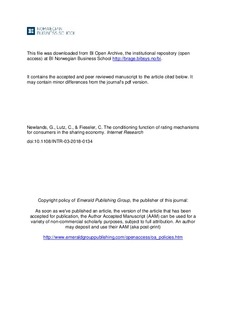| dc.contributor.author | Newlands, Gemma Elisabeth Marjorie | |
| dc.contributor.author | Lutz, Christoph | |
| dc.contributor.author | Fieseler, Christian | |
| dc.date.accessioned | 2019-06-28T12:40:32Z | |
| dc.date.available | 2019-06-28T12:40:32Z | |
| dc.date.created | 2019-01-08T11:22:26Z | |
| dc.date.issued | 2019 | |
| dc.identifier.citation | Internet Research. 2019, | nb_NO |
| dc.identifier.issn | 1066-2243 | |
| dc.identifier.uri | http://hdl.handle.net/11250/2602833 | |
| dc.description.abstract | Purpose
The purpose of this paper is to explore how rating mechanisms encourage emotional labor norms among sharing economy consumers.
Design/methodology/approach
This study follows a mixed-methods research design. Survey data from 207 consumers were used to quantify the impact of three distinct rating dimensions on a consumer behavioral outcome (emotional labor). In the second step, 18 focus groups with 94 participants were used to investigate the conditioning functions of ratings in more depth.
Findings
Rating mechanisms condition consumers toward performing socially desirable behaviors during sharing transactions. While consumers accept the necessity of bilateral rating mechanisms, they also recognize their coercive nature. Furthermore, the presence of bilateral rating mechanisms leads to negative outcomes such as annoyance and frustration.
Originality/value
This study contributes to sharing economy literature by examining bilateral rating mechanisms as a means of behavioral conditioning for consumers. This study points to improvements in platform design and informs theory on tripartite markets as well as trust. | nb_NO |
| dc.language.iso | eng | nb_NO |
| dc.publisher | Sage | nb_NO |
| dc.subject | Sharing economy | nb_NO |
| dc.title | The Conditioning Function of Rating Mechanisms for Consumers in the Sharing Economy | nb_NO |
| dc.type | Journal article | nb_NO |
| dc.type | Peer reviewed | nb_NO |
| dc.description.version | acceptedVersion | nb_NO |
| dc.rights.holder | Copyright policy of Emerald Publishing Group, the publisher of this journal: As soon as we've published an article, the version of the article that has been accepted for publication, the Author Accepted Manuscript (AAM) can be used for a variety of non-commercial scholarly purposes, subject to full attribution. An author may deposit and use their AAM (aka post-print) | nb_NO |
| dc.source.pagenumber | 19 | nb_NO |
| dc.source.journal | Internet Research | nb_NO |
| dc.identifier.doi | 10.1108/INTR-03-2018-0134 | |
| dc.identifier.cristin | 1652180 | |
| dc.relation.project | EC/H2020/732117 | nb_NO |
| dc.relation.project | Norges forskningsråd: 247725 | nb_NO |
| cristin.unitcode | 158,9,0,0 | |
| cristin.unitname | Institutt for kommunikasjon og kultur | |
| cristin.ispublished | true | |
| cristin.fulltext | postprint | |
| cristin.qualitycode | 1 | |
